Hunting Iowa’s Late Season!
HUNTING IOWA’S LATE SEASON!
By Rich Waite
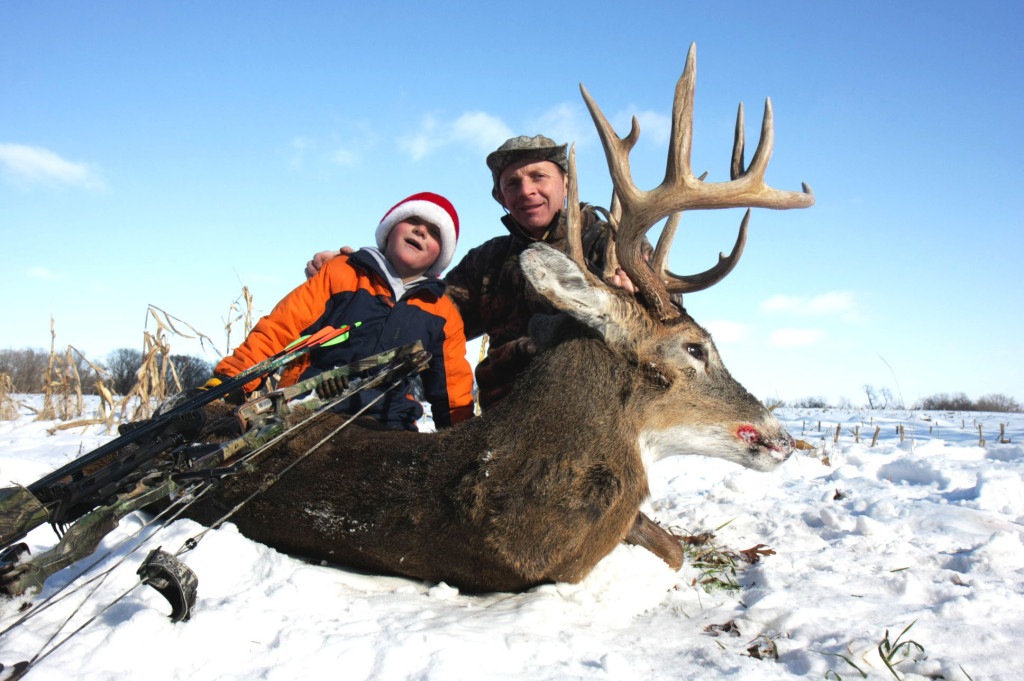
I’d been scanning the forest floor for over an hour when, from out of nowhere, he appeared, eyes piercing my camo coveralls like a laser beam. wondered. And how ‘d he peg me like that? Just hold still, now, Rich. He’s got to be looking at something else. I’m not moving, I’m camouflaged head to toe, and I’m tucked into this dense cedar foliage like a tick on a dog’s back. Besides, that frosty December breeze is in my face, so he can ‘t smell me either.
When a nearby doe stole the buck’s attention, I inched my muzzleloader up and peered through the scope, centering the cross hairs in the middle of his rib cage. This buck was a keeper indeed – a typical 3 1/2-year-old 8-pointer that would score around 140 points on the Boone and Crockett scale.
The scope’s cross hairs bobbed and swayed before settling solidly on the broadside buck.
Decisions…decisions…it was now or never but did I really want to shoot this buck?
I was thinking I did at first but a quick daydream image of his 170 inch rack swaying through the trees next year prompted me to lay my muzzlegun back down into my lap.
Soon, daylight evaporated from the field and darkness enveloped the forest. Can’t wait to get home and tell my wife: maybe I didn’t shoot one – but 95% of the fun is in the encounter. And I’d definitely had one of those. What fun it is!
Adrenaline-gushing fun like that happens every January in the Iowa outdoors – but you need to hunt in the right places and use appropriate hunting tactics if you want it to happen to you.
NORTHEAST IOWA
Northeast Iowa is home to more than just dairy cows and Iowa Hawkeye fans. It is home to big bucks too……some of them world-class! The best areas tend to be north and east of an imaginary line extending roughly from Cedar Rapids through Decorah and on up to the Minnesota state line. Deer thrive in the mixed rolling agricultural landscape here, and bucks survive to trophy status by outmaneuvering hunters in the steep limestone ridge topography along the waterways.
Which places are tops for a late season smokepole buck hunt in this region? Private land is tops. But don’t get the idea that big bucks aren’t available on this region’s public land! Good-to-excellent prospects for beastly bucks on public land exist here for hunters willing to seek out those remote, overlooked locales. Too, many public lands offer superb chances if you simply want a tasty doe for the freezer. Remember: giant bucks are taken from these public areas annually. It might as well be you that shoots one this year instead of the other guy next season.
As far as hunting private land goes, friends and family members of landowners typically get first dibs. But a door knocking may reveal that, while many of these folks hunted earlier, most just don’t hunt the late season. The result? Often, permission to hunt the last season is granted to polite and courteous hunters. And if you brink back a bottle of wine and some venison sausage to the landowner around Christmas time – there’s pretty good odds you’ll get to room his fields and forests the upcoming season again.
I took up late-season muzzleloader hunting many years ago in part because of those open-armed responses I’d get from landowners when I sought their permission to hunt. Another reason was the low number of hunters in the field! And the bucks. Oh, yes – the bucks! The shotgunners and bowhunters didn’t, get them all – that I will assure you!
Here are some top public lands to check out in northeast Iowa: Yellow River State Forest, 7,889 acres in Allamakee County south of Harpers Ferry; 571- acre North Bear and 845-acre South Bear, complexes northeast of Decorah in Winneshiek County; Volga River State Recreation Area, 5,422 acres just north of Fayette in Fayette County; Bloody Run Creek, 610 acres east of Monona in Clayton County.
In Jones County, check out Pictured Rocks, 863 acres. In Jackson County, tty Big Mill Creek, 737 acres,just west of Bellevue.
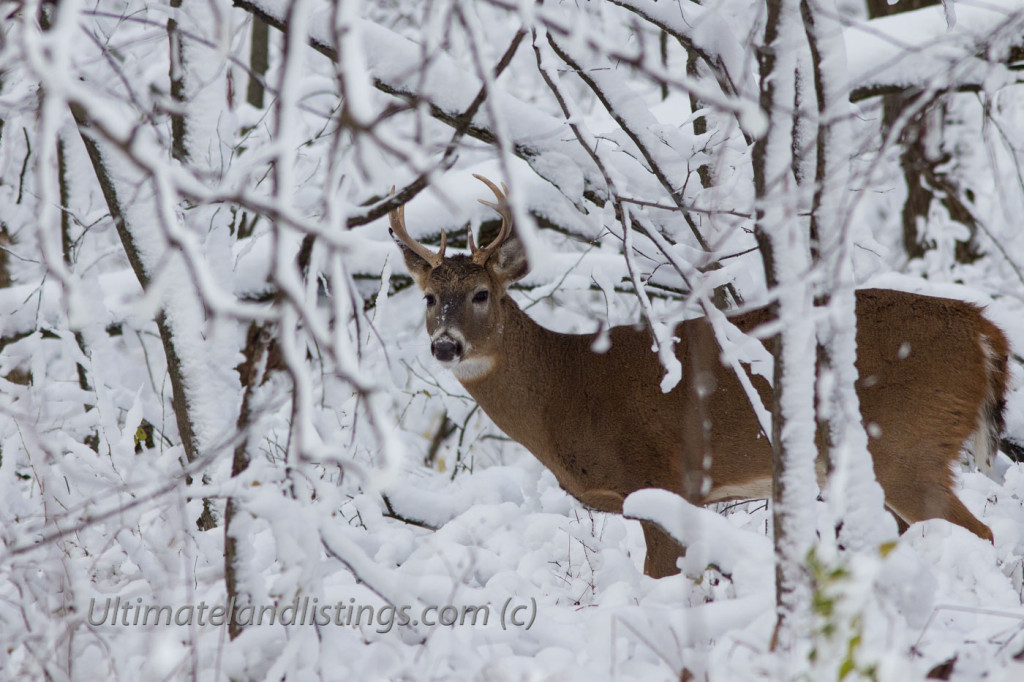
A young — 1.5 year-old — Iowa whitetail buck is hiding in a dense stand of plum and honeysuckle. The big boys like to do the same thing! Find a good food source close to good cover like this and you will should find deer, maybe the deer of a lifetime!
SOUTHERN IOWA
Southern Iowa – south of 1-80 – is as good for growing big whitetail bucks as it is for growing arm-ripping multiflora rose bushes and boot-stabbing thorny honey locust trees – there being plenty of all three of these “down south.”
Where do you go to find big bucks in southern Iowa? As in northeast Iowa, private land can be stellar. But southern Iowa is rich in public land too and big bucks routinely come from such places too.
Keep in mind that all it takes is three years for an Iowa buck to produce a rocking chair-size rack. Find a spot that annually gets overlooked by hunters and you’ve just dipped into a probable big-buck pool.
So, hunters shouldn’t neglect public land. Just look for little hidden or remote out-of-the-way places on public land and you may be in for a big buck surprise.
Said the late, great, Iowa Department of Natural Resources biologist Willie Suchy in an interview with me a while back, “Many hunters shy away from the public lands after the first shotgun season. But you can find. overlooked trophies if you’re willing to get away from the access points.”
Here are some key public lands in this part of the state: Shimek State Forest, Des Moines County (all units), 8,090 acres west of Donnellson; Shimek State Forest, Van Buren and Lee counties, 9,008 acres southeast of Farmington; Eldon Wildlife Area, Davis County, 925 acres west of Eldon; Fox Hill Wildlife Area, county, 1,297 acres southeast of Ottumwa; Rathbun Wildlife Area, Appanoose County, 15,629 acres north of Centerville; Stephens State Forest, Lucas County, 6,226 acres northeast and west of Chariton; Sand Creek Wildlife Area, Ringgold County, 3,280 acres east of Tingley; Copeland Bend, Fremont County (river access only), 469 acres west of Sidney.
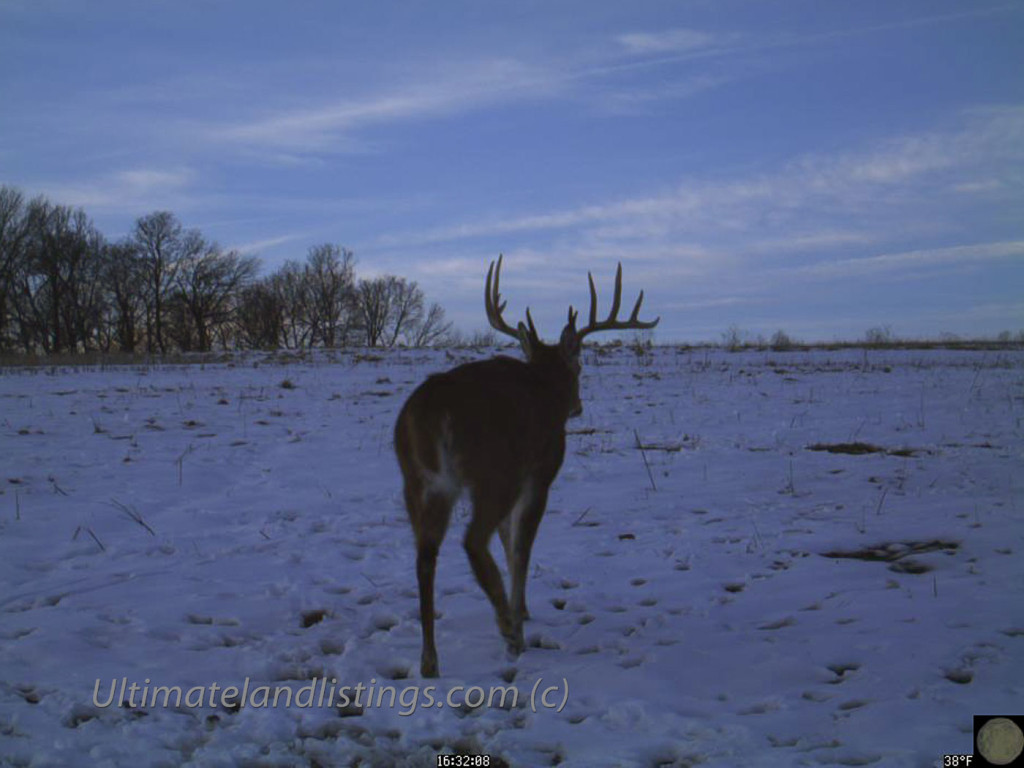
THE REST OF THE STATE
Make no mistake; you don’t have to hunt northeast or southern Iowa to take a big January buck. IDNR records prove that big bucks live in every county of the state. All it takes is three years for an Iowa buck to produce a big set of antlers. Find a spot that annually gets overlooked by hunters and you’ve just dipped into a probable big-buck pool.
Marshes and waterways across all of central and northwest Iowa cough up plenty of nice bucks, if only because that is where most of the thick-cover habit is located. But don’t you neglect those withering fencerows, tiny wood lots, and isolated patches of “pheasant” grass! Unlikely pieces of deer cover like these are the homes of pressured trophies throughout the hunting season – and throughout the state – because these places often get bypassed by hunters. Most of the hunting in central and northwestern Iowa occurs on private land. And receiving permission here isn’t too terribly difficult.
What about western Iowa? Well, it surrenders lots of big bucks each year – many of these bruisers coming from the rugged topography of the Loess Hills region where bucks can grow old. Find good habitat on private land in this area and you are in big-buck heaven. Or, check out the various tracts of the Pioneer Forest, which are scattered throughout the Loess Hills region, between Council Bluffs and Sioux City. Do some snooping in isolated locales on those public parcels and you’re going to bump into a bruiser at some point.
HUNTING UP A JANUARY BUCK
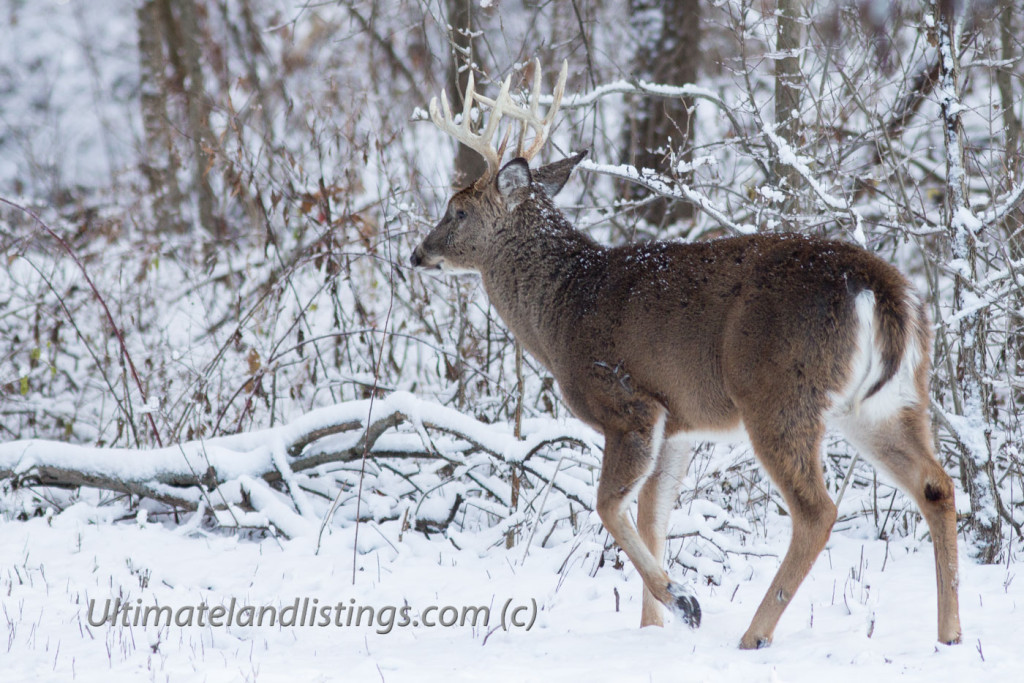
A friend and frequent hunting companion is Kevin Oetken of northeast Iowa. While hunting with Kevin over the years, I’ve learned two things: He is as persistent as a bad case of poison ivy and he’s a crack shot. Oh yeah, he must carry around a rabbit’s foot and a four-leaf clover because he seems to be as lucky as lucky can be.
Kevin’s a forester by trade and spends every working day in the deer woods and when he’s not at work, guess where he’s likely to be? Back in the deer woods, weapon in hand! Kevin started out in the
mid-l980s hunting the early October muzzleloader season, but soon found favor in the late season for the special challenges and rewards it offers. And every year, he either shoots a big buck or tags a doe for the freezer. He’s taken many bucks that gross more than 150 Boone and Crockett points over the years with his muzzleloader, plus several other bucks most hunters would simply love to have a crack at. What’s his secret?
“Food, that’s the real key, to lowering the hammer on a late-season trophy,” said Kevin as we rolled down a dusty gravel road one summer evening on a scouting foray. “Find a reliable food source that is fairly close to good bedding cover and isolated from disturbances from humans.”
Simply put, wintertime whitetails are primarily interested in filling their bellies. So finding a good deer food source is of primary importance to the late-season hunter. The top whitetail attraction? A standing field of com or beans – these draw deer like a magnet draws metal shavings. But finding a field like that on your hunting area is akin to winning the state lottery – don’t hold your breath that it’s going to happen to you.
“That’s for sure,” muses Kevin, “but those big boys use the harvested grain fields too, since 99 percent of the time that’s what’s available to them. The buck I shot a few years ago was coming back from just such a field one blustery morning. I was sitting up a steep draw getting blasted by buckshot ice pellets when the old boy tried sneaking up the other side to his bed. Shivering a bit, I steadied the gun on a nearby tree and got off a good shot.”
I remember my phone ringing that morning as I sipped on a steamy mug of coffee; it was Kevin with the news. Persistence pays!
Kevin and I hunt together regularly and have refined our hunting techniques over the years by way of magazine article and book learning but mostly by way of trial-and-error hunting. So when I quizzed him a little more, the answers I received were no surprise.
How do you know which fields to hunt?
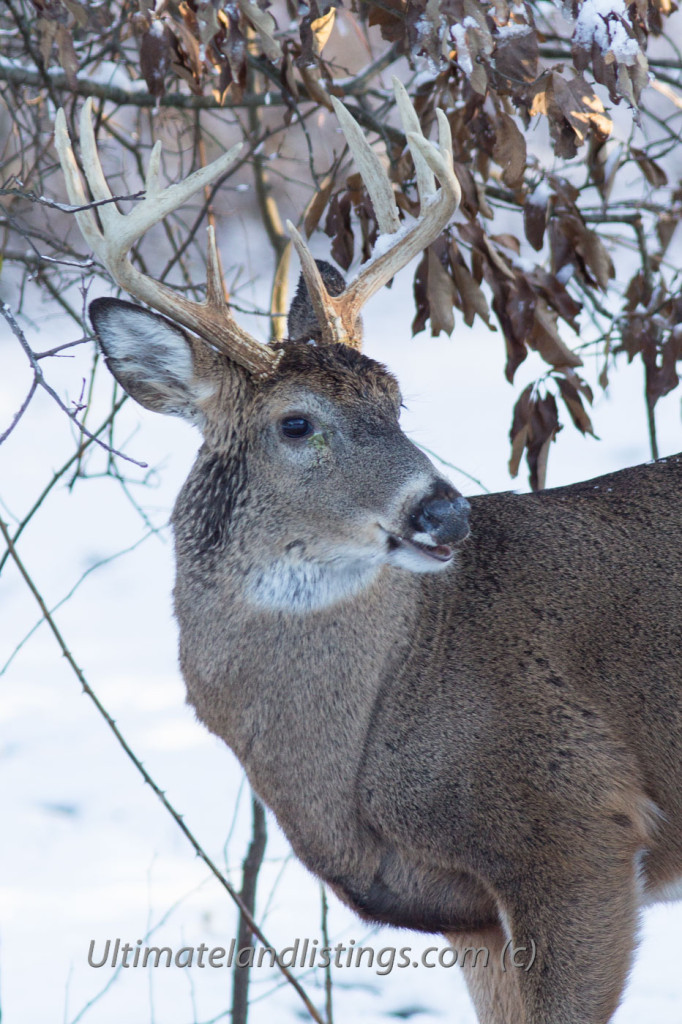
“First, I predict where whitetails are probably bedding by looking over photos or maps of an area or by relying upon past experience,” said Kevin. “Then· I tip-toe around nearby grain fields during midday hours, scanning for tracks and droppings in the snow and noting any possible stand sites near the feeding area.
“But you need to be very, very careful when scouting those fields because deer are likely to be bedded close by,” warns Kevin. “Never scout a field if your scent will be blowing into suspected bedding areas and never traipse through cover! Disturbing bedded deer late in the season is the quickest recipe for disaster that I know of. But you do need to find those feeding fields to pull off a successful stand hunt.
“And about placing a stand,” continues Kevin, “be absolutely positive that it’s in such a spot where the odds of getting detected in any way by a whitetail are the lowest possible – this means being downwind of where all deer are suspected to be while you’re on stand and while you enter and exit your stand. Also, I like my stand site to back against something or against someplace where deer are either unlikely or unable to travel. Such as, against a rock bluff, adjacent to a plowed field or next to a blow-down or some other obstacle. This is good insurance against deer accidentally lurking downwind past your stand and smelling you. It also enables me to sneak out of my stand and back to my house or vehicle undetected by upwind whitetails in the dark.” I agree 100 percent.
Over the years, I’ve found that midwinter bucks don’t like to move far between feeding and bedding sites if they don’t have to, particularly if heavy snow blankets the ground.
“That’s why I normally hunt right at the field’s edge on evening hunts,” confirms my friend. “It usually doesn’t take them long to show up once they decide to chow. Remember, deer will feed off and on all day long on bitter cold days – temperatures below about 20 degrees. So you need to be on stand early if such is the case.” “The colder the day, the earlier you can expect to see deer movement in the afternoon”. “If it’s really bitter cold, expect mid-day feeding activity, even with the biggest of bucks,” says Kevin. And I concur!
This brings up a hunt I had a while back. I’d just shimmied up a little cedar tree and sat down in my stand when I heard a rustling of branches within the timber in front of me. I looked up and here comes a doe that proceeded to feed in the bean field a scant 25 yards away. The time: 12:30 p.m.! Fortunately, I had past experience guide me correctly and I arrived at my stand early that day because of the heavy snow cover and single-digit temperatures. I watched the doe feed for all of 15 minutes before a really good 4.5 year old buck arrived at the scene. This one’s a shooter, I thought, as I cautiously raised my muzzleloader and made the easy 25-yard broadside shot. The time: 12:50 p.m. I guess it was lunch hour for the whitetails too! Your lunch hour is the same as their lunch hour when the ground is thick with white and temperatures are in the single digits or lower!
Of course, there are other ways of taking a late-season buck than by stand-hunting near food sources. “When the weather is mild and there’s not much snow on the ground, then my stand hunting success dwindles,” admits Oetken. “That’s when I still-hunt ’em up, by inching my way through likely bedding cover. This is really a favorite hunting method even though the odds of taking a big buck this way may be lower than hunting on a cold-weather stand near food.
“Still, I’ve taken several nice bucks this way. I focus my still-hunting on south-facing slopes, finger ridges, cedar/pine thickets, brush-choked entanglements and the like – places midwinter bucks like to bed.”
So you’d like to shoot a nice buck this season with your muzzleloader? Well, bundle up and try some of these places and tactics. Iowa’s bitter January woods heat right up when your adrenaline is pumping because there’s a big buck under your stand!
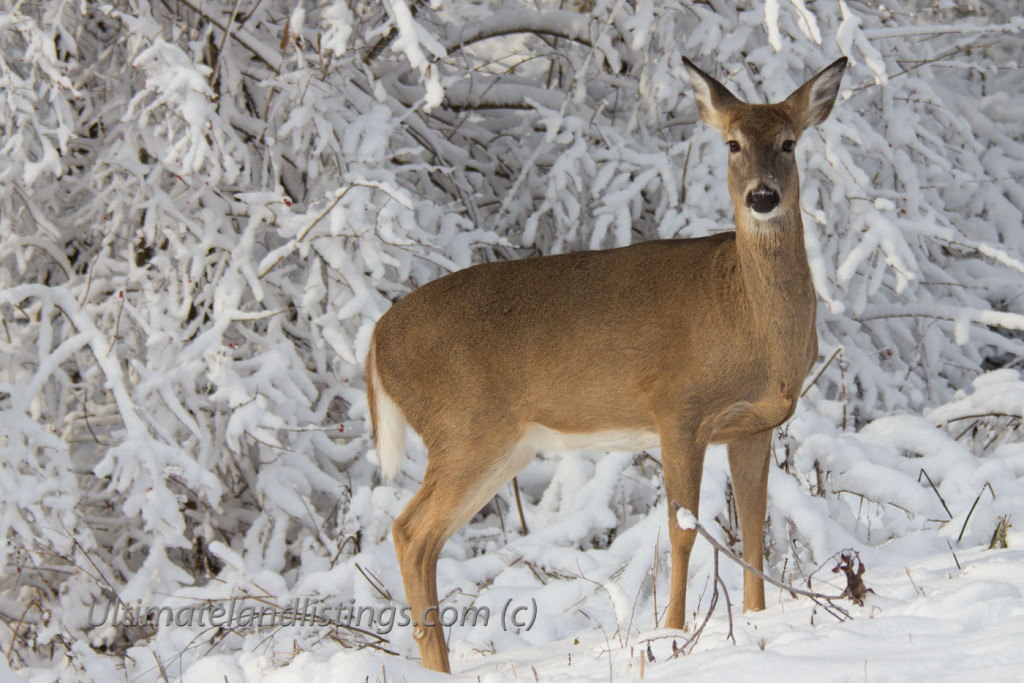
Don’t forget — Venison is a one the tastiest and healthiest of all the red meats. Shooting a doe for the freezer is a good deal if you don’t shoot a big buck!

